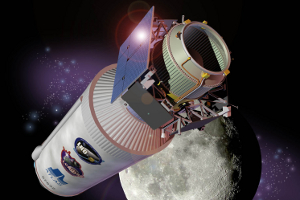"If you took the 10 kilometer region around the LCROSS site, that is said to have 5 percent concentration of water, that would be equivalent to a billion gallons of water," said Tony Colaprete, the principal investigator on the Lunar Crater Observation and Sensing Satellite mission to search for water on the moon. A billion gallons is enough to fill 1500 Olympic-sized swimming pools. The lunar scientists now suspect that there is 50 percent more water than they had previously estimated.
Colaprete also said that given the large number of craters on the moon, which function as "cold traps" that accumulate molecules of water over billions of years, "potentially, you could have 10 to 100 times that total amount of water."
"We found some of the coldest places in the solar system and they’re on our moon. These places have temperatures that are so cold that they can preserve water ice in a vacuum for billions of years," said Michael Wargo, a chief lunar scientist at NASA headquarters in Washington, D.C.
The lunar water is thought to exist in "oases," or deposits, instead of being uniformly distributed across the moon. It also exists mainly in the form of water ice crystals.
"That's good news because water ice is very much a friendly resource to work with. It's easy to extract and turn it into a resource, you don’t have to warm it very much, you can pull it out of the dirt really easy," said Colaprete, who described a process of extraction whereby the ice-bearing lunar soil could be heated to 100 degrees Celsius to collect the water vapor.
During the live NASA teleconference, the scientists said that the amount of other materials they detected on the moon - including mercury, ammonia, methane, carbon dioxide, sodium and silver - may make up as much as 20 percent of the lunar dust plume kicked up by the impact of the LCROSS rocket.
Both discoveries could be instrumental in one day making it easier to set up a lunar colony, the researchers said, because of the high cost of transporting materials to the moon, which can exceed thousands of dollars per pound.
Last year, NASA shot a Centaur rocket carrying the LCROSS and Lunar Reconnaissance Orbiter from Cape Canaveral, Florida, and in October, they deliberately crashed the rocket at 6,000 mph into Cabeus, a cold, dark crater on the moon’s south pole that hasn’t seen sunlight in billions of years.
The impact sent up a plume of lunar soil and debris several miles over the crater’s rim, exposing it to sunlight. Meanwhile, the spacecraft collected data for four crucial minutes, allowing scientists to analyze the chemical makeup of the ejected lunar soil, before it too crashed into the crater. Since then, the LCROSS team has been sifting through the information to glean clues about earth’s 4.5 billion year-old neighbor.
So how did the water get there? According to Colaprete, it’s likely a combination of sources. One way it could have arrived is from solar wind depositing hydrogen into the lunar granules which contain oxygen atoms. Another way is from impacts by icy comets slamming into the moon, a theory supported by the observation of these other chemicals and hydrocarbons that also exist in comets.
The last manned lunar mission was Apollo 17 in 1972. In recent years, the U.S., along with Japan, China and India have launched various unmanned lunar mission. NASA is scheduled to launch two other lunar exploratory missions, GRAIL and LADEE in 2011 and 2012, respectively, to map the moon’s interior structure and further analyze the moon’s dust.
Sometime in the next several decades, a new generation of astronauts may return to set up a lunar outpost, setting the stage for future missions to Mars.
“In the next 20 years, next 10 years, you’re going to see the moon continue to expand in its diversity, and its complexity and its interest, among the communities of both laypeople and professionals and that’s going to pull us there,” said Colaprete.
Instruments currently orbiting the moon are allowing the scientists to map in much greater detail hydrogen-rich, lunar "permafrost" regions that may contain deposits of water ice and other compounds that could help support a future lunar colony.
But before that lunar colony can be set up, there has to be a more sophisticated understanding of where exactly the water is and how easy or difficult it will be to mine when it's found.
"The next step is to look at smaller and smaller scales at the lunar surface of the distribution of water as a resource," said Colaprete.
"If I were an astronaut walking along, how far do I have to walk before I find some water and how extensive are these pockets of water?"
37.52119957659491 -122.0086669921875
 Artist's rendering of the LCROSS spacecraft and its upper stage Centaur rocket. Image courtesy of NASA.
Artist's rendering of the LCROSS spacecraft and its upper stage Centaur rocket. Image courtesy of NASA.